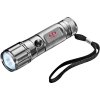The late Frank Sudol had a light taped adjacent to the cutter on his boring bars. This was used to transmit light through the walls of birch hollow forms, thereby determining the wall thickness. Using the method he could get down to a consistent 1/16". He used an automotive bulb because it handled vibration well. He used a 12 volt power supply to transform 120 v. AC current, and taped the wires to the boring bar.
This was about 8 or 10 years ago. I'd like to know if anyone has set up a similar system and if they could give me some advise and suggestions. I don't know any more about Frank's set up than mentioned above, and I'm not particularly skilled in electricity. What kind of bulb and power supply should I use? What should I watch out for? In other words, help! Many thanks. I really appreciate it.
Dale Clemens
This was about 8 or 10 years ago. I'd like to know if anyone has set up a similar system and if they could give me some advise and suggestions. I don't know any more about Frank's set up than mentioned above, and I'm not particularly skilled in electricity. What kind of bulb and power supply should I use? What should I watch out for? In other words, help! Many thanks. I really appreciate it.
Dale Clemens

